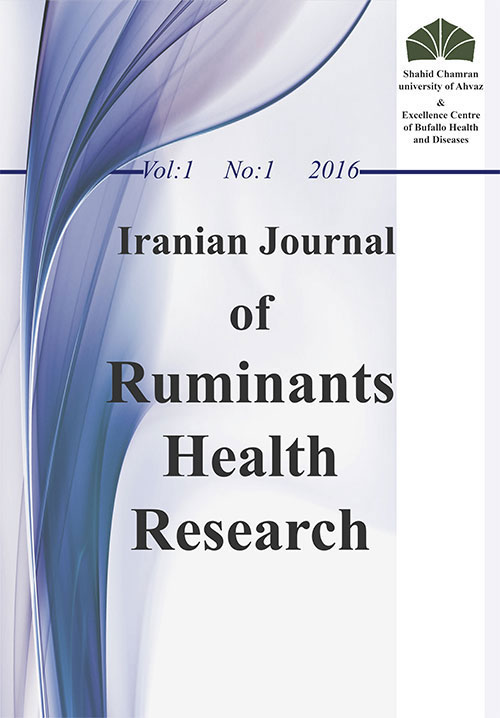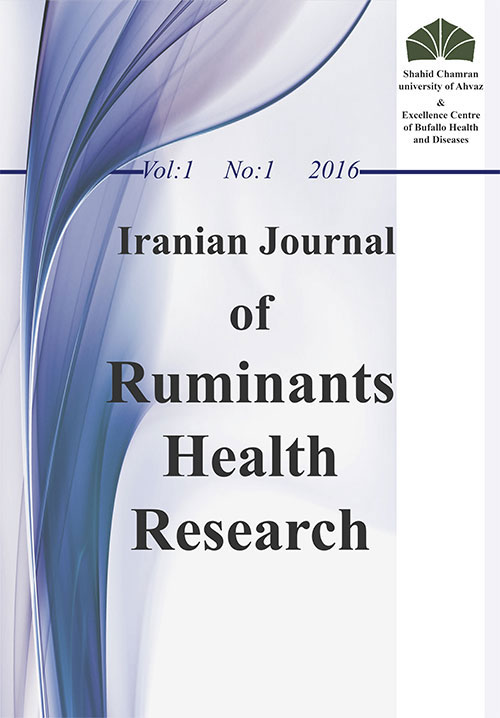فهرست مطالب

Journal of Ruminants Health Research
Volume:2 Issue: 2, Summer and Autumn 2017
- تاریخ انتشار: 1396/08/10
- تعداد عناوین: 6
-
-
Pages 1-22Information regarding metabolic profile in different physiological periods of ewes can assist veterinarians to monitor the herd health and productive performance. Furthermore, the relationships among the metabolic parameters can be used to detect the effect of each parameter on another one. Five clinically healthy adult Ghezel ewes were selected at 4 weeks before parturition and evaluated at 4 and 2 weeks before, 2 and 4 weeks and 2, 3 and 4 months after parturition. Blood samplings were performed from each animal at the above mentioned periods, in the meantime, serum concentrations of glucose, BHBA, NEFA, cholesterol, TG, HDL, LDL, VLDL, insulin, T3, T4, prolactin, cortisol and IGF-1 were measured in all specimens. In all studied periods, glucose was negatively correlated with Insulin, BHBA, and NEFA. The positive significant correlation was detected between glucose and cortisol. BHBA had a positive and significant correlation with NEFA in all ewes. BHBA and NEFA were significantly correlated, negatively and positively, with insulin and cortisol, respectively. Cortisol had both significant and positive relationships with TG, cholesterol, HDL, LDL, and VLDL. Insulin had significant negative and positive correlations with cortisol and both IGF-1 and prolactin, respectively. Moreover, there was a negative significant correlation between cortisol, IGF-1 and prolactin in all ewes. Significant positively relationship was detected between IGF-1, and prolactin at all groups. T3 and T4 were significantly positive related together. Information regarding the correlations among circulating metabolic parameters can be used to estimate the changing patterns of each metabolic parameter via evaluating the others.Keywords: Metabolic profile, Endocrinology, Normal level, Correlation, Ghezel ewe
-
Pages 23-30Fasciolosis is a zoonotic parasitic disease with worldwide distribution. The disease causes significant economic losses in herd industry including decrease animal products such as meat, milk and infertility reduction. Human can acquire infection as accidental host especially in areas with high level of raining and humidity. Previous studies showed the prevalence of infection among meat-product animals based on inspiration of carcasses in abattoirs using macroscopic test. It seems that the inspiration evidence is not quite precise because the early infection cannot be recognized by macroscopic examination. Therefore, the present cross-sectional study was conducted to determine the Prevalence of fasciolosis on ruminants slaughtered at Ahvaz abattoir, Khuzestan province. Totally, 60 blood and fecal samples of sheep, 50 samples of cattle and 50 samples of buffalo were randomly collected through April to May 2016. Fecal samples were examined using concentration by flotation techniques for the presence of Fasciola ova. The sera from blood sample tested for the presence of anti Fasciola spp antibodies by ELISA technique and livers of slaughter animals were checked for presence of Fasciola spp infestation. In this study, Seroprevalence of fasciolosis was 5% for sheep, 20% for cattle and 18% for buffaloes. The incidence of liver fasciolosis in sheep, cattle and buffaloes samples were 6.6%, 18% and 12% respectively. Microscopic examination in fecal test was negative.Keywords: Fasciolosis, Ruminants, Abattoir, Elisa
-
Pages 31-40
Foot-and-mouth disease (FMD) is a highly contagious viral disease of ruminants, which causes fever and blisters in their mouth and feet. This study, as a case- study design, was conducted to determine the factors related to FMD occurrence in the industrial dairy farms of Qazvin Province, Iran. The case unit was referred to any industrial dairy farms that had at least one cow or calf with clinical signs of FMD within the past three years. The control unit included industrial dairy farms that had a cow without a history of FMD in the same district where the case occurred within the past three years. Determinants of the disease were collected using a questionnaire. The incidence of FMD had a significant correlation with the new livestock arrival (OR=5.91 95% CI=1.54-22.5, P=0.009), vaccination (OR=0.054 95% CI=0.012-0.344, P <0.001), health status of animal husbandry (OR=0.17 95% CI=0.048-0.584, P=0.005) and livestock population unit (OR=0.22 95% CI=0.062-0.79, P=.021). Regarding the identified risk factors in the present study, it seems necessary to hold training sessions for owners and workers working in livestock farms as well as livestock traders and drovers about the epidemiology of FMD to increase their awareness, attitude and practice in the prevention of the disease and to improve the implementation of disease control programs.
Keywords: Foot-and-mouth disease, dairy farms, related factors, case-control, Qazvin -
Pages 41-57Primary chronic forms of copper poisoning have been reported to occur in goats around the copper industries in Kerman province. The survey was carried out from autumn 2015 to the end of summer 2016, in Kerman province, Iran. Based on clinical signs, confirmed by necropsy and copper concentration of serum and different tissues, ten live chronic copper poisoned (CCP) goats were used in the study in each season. Blood samples were then taken. Samples from hair, liver, lung, kidney, heart and spleen were collected and copper was measured by Atomic Absorption Spectrophotometery. The highest levels of copper in lung, heart, liver, kidney and hair were observed in winter. Spleen had the highest concentration of copper in the summer. The lowest concentration of copper in serum, kidney, liver, heart, lung and hair was detected in spring. The lowest level of copper in the spleen was seen in winter. In spring, copper contents of liver had significant and positive relationships with copper level of lung, heart and spleen (p<0.05). Significant correlations were found between various tissues in different seasons. The highest and lowest serum concentration of molybdenum was observed in spring and winter, respectively (p<0.05). Serum ceruluplasmin significantly decreased in all seasons (p<0.05). In conclusion, the results of the current research showed that the level of copper in CCP goats is season-dependent. Significant correlations were also observed between different tissues in certain seasons in CCP goats. Ceruloplasmin decreased in CCP goats as a result of liver damage.Keywords: Chronic copper poisoning, Goats, Season
-
Pages 59-74Endotoxemia is a common and life threatening inflammatory condition in calves which can lead to shock, multiple organ dysfunction, and immunosuppression and biochemical dyshomeostasis. In order to correct peripheral perfusion and metabolic disturbances, hypertonic fluids are recommended as part of treatment. The aim of the present study was to determine the resuscitating effects of hypertonic solutions (NaCl 7.2% and NaHCo3 8.4%) on endotoxemia-induced biochemical alterations. Nine Holstein male calves were randomly divided into three groups (control; n=3 and two treatment; n=6). All calves were injected bacterial Lipopolysaccharide (LPS) and were monitored for four hours post administration (p.a) at several regular intervals. Biochemmical parameters such as Total protein (TP), Fibrinogen (Fib), Lactate, Cortisol and Adrenocorticotropic hormone (ACTH) were measured as well as Rectal Temperature (RT), Respiratory Rate (RR) and Heart Rate (HR). Approximately, blood biochemistry showed significant change in all parameters following endotoxemia which were corrected by hypertonic solution interventions. The present study demonstrated that hypertonic sodium bicarbonate exerted its resuscitating effects by more abrupt increase of ACTH and Cortisol levels.Keywords: Endotoxemia, Resuscitation, Calve, Hypertonic solution
-
Pages 75-92
This study was conducted on 384 clinically healthy sheep and goats from farms around Tehran suburb. The animals were divided into two equal groups (according to species) and then assigned into three age groups, two gender groups and female animals into two groups: late pregnant and non-pregnant. Heart sounds were auscultated by two cardiologists and heart rate and probable murmurs were recorded. Using the base-apex lead, the electrocardiograms were taken. Three types of dysrhythmias including sinus tachycardia, sinus arrhythmia and atrial premature complex were observed. Regarding the incidence of dysrhythmias, there were significant statistical differences between the age and sex groups, but not between pregnant and non-pregnant animals. The mean heart rate of sheep and goats with sinus arrhythmia was significantly lower than those with regular cardiac rhythm (p<0.001). The prevalence of the murmurs in sheep and goats, which all were systolic, were 6.3% and 8.9%, respectively. Only one holosystolic murmur was detected in a sheep and the others were early to early-mid systolic murmurs. One murmur was detected with grade 3/5 in sheep and other murmurs were grade 1 and 2. The number of murmurs on the mitral valve was higher in age groups 1 (< 6 months) and 2 (6-12 months) compared to group 3 (> 12 months). But there was no significant relationship between the incidence of murmur and age, gender and pregnancy. The results of this study revealed that small ruminants have lower prevalence of dysrhythmias and murmurs compared to cattle and horses.
Keywords: dysrhythmia, murmur, Sheep, Goat


